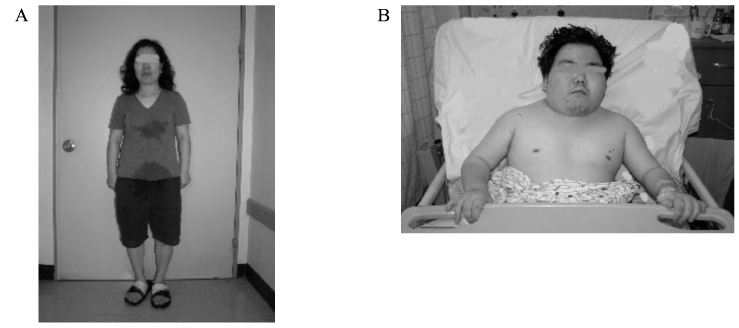J Korean Endocr Soc.
2009 Sep;24(3):195-200. 10.3803/jkes.2009.24.3.195.
A Case of Pseudohypoparathyroidism Worsened by Rhabdomyolysis
- Affiliations
-
- 1Department of Internal Medicine, Hanyang University Guri Hospital, Korea.
- KMID: 2178182
- DOI: http://doi.org/10.3803/jkes.2009.24.3.195
Abstract
- The term pseudohypoparathyroidism describes a rare disorder characterized by resistance to the action of immunoreactive parathyroid hormone (PTH) in peripheral tissue rather than a deficiency of PTH. Patients present with tetany, spasm, hypocalcemia, hyperphosphatemia, and Albright's hereditary osteodystrophy (AHO). We present a case of symptomatic hypocalcemia due to pseudohypoparathyroidism aggravated by rhabdomyolysis. A 21-year-old man presented with tetany, AHO phenotypes and an ankle infection. Rhabdomyolysis was confirmed by marked elevation of serum creatine phosphokinase, more than 10 times above normal. Spasm was observed and the serum value of total calcium was as low as 3.7 mg/dL and that of phosphate was as high as 7.0 mg/dL, and the peak level of PTH was at 80.4 pg/mL. Although not surveyed by Ellsworth-Howard test and molecular study, it was classified as pseudohypoparathyroidism type 1a or 1c. The clinical and laboratory abnormalities were corrected by vitamin D in addition to calcium. The patient's mother, sister, and grandmother had AHO phenotypes without clinical and biochemical manifestations. To the best of our knowledge, this is the first case by maternal inheritance that AHO phenotypes appear for three generations of a family in Korea.
Keyword
MeSH Terms
-
Animals
Ankle
Calcium
Creatine Kinase
Family Characteristics
Fibrous Dysplasia, Polyostotic
Humans
Hyperphosphatemia
Hypocalcemia
Korea
Mothers
Parathyroid Hormone
Phenotype
Pseudohypoparathyroidism
Rhabdomyolysis
Siblings
Spasm
Tetany
Vitamin D
Wills
Young Adult
Calcium
Creatine Kinase
Fibrous Dysplasia, Polyostotic
Parathyroid Hormone
Vitamin D
Figure
Reference
-
1. Albright F, Brunett CH, Smith PH, Parson W. Pseudo-hypoparathyroidism: an example of "seabright-Bantam syndrome". Endocrinology, Baltimore. 1942. 30:922–932.2. Drezner M, Neelon FA, Lebovitz HE. Pseudohypoparathyroidism type II: a possible defect in the reception of the cyclic AMP signal. N Engl J Med. 1973. 289:1056–1060.3. Lalande M. Imprints of disease at GNAS1. J Clin Invest. 2001. 107:793–794.4. Chase LR, Melson GL, Aurbach GD. Pseudohypoparathyroidism: defective excretion of 3',5'-AMP in response to parathyroid hormone. J Clin Invest. 1969. 48:1832–1844.5. Windeck R, Menken U, Benker G, Reinwein D. Basal ganglia calcification in pseudohypoparathyroidism type II. Clin Endocrinol (Oxf). 1981. 15:57–63.6. Akmal M, Bishop JE, Telfer N, Norman AW, Massry SG. Hypocalcemia and hypercalcemia in patients with rhabdomyolysis with and without acute renal failure. J Clin Endocrinol Metab. 1986. 63:137–142.7. Gabow PA, Kaehny WD, Kelleher SP. The spectrum of rhabdomyolysis. Medicine (Baltimore). 1982. 61:141–152.8. Llach F, Felsenfeld AJ, Haussler MR. The pathophysiology of altered calcium metabolism in rhabdomyolysis-induced acute renal failure. Interactions of parathyroid hormone, 25-hydroxycholecalciferol, and 1,25-dihydroxycholecalciferol. N Engl J Med. 1981. 305:117–123.9. Massary SG, Arieff AI, Coburn JW, Palmieri G, Kleeman CR. Divalent ion metabolism in patients with acute renal failure: studies on the mechanism of hypocalcemia. Kidney Int. 1974. 5:437–445.10. Davis AM. Hypocalcemia in rhabdomyolysis. JAMA. 1987. 257:626.11. Cape CA. Phosphorylase a deficiency in pseudohypoparathyroidism. Neurology. 1969. 19:167–172.12. Kawata A, Suga M, Hayashi H, Tanabe H. Rhabdomyolysis associated with pseudohypoparathyroidism type Ib--a case report. Rinsho Shinkeigaku. 1993. 33:331–333.13. Piechowiak H, Gröbner W, Kremer H, Pongratz D, Schaub J. Pseudohypoparathyroidism and hypocalcemic "myopathy". A case report. Klin Wochenschr. 1981. 59:1195–1199.14. Chase LR, Aurbach GD. Parathyroid function and the renal excretion of 3'5'-adenylic acid. Proc Natl Acad Sci U S A. 1967. 58:518–525.15. Farfel Z, Friedman E. Mental deficiency in pseudohypoparathyroidism type I is associated with Ns-protein deficiency. Ann Intern Med. 1986. 105:197–199.16. Bastepe M. The GNAS locus and pseudohypoparathyroidism. Adv Exp Med Biol. 2008. 626:27–40.17. Kang MH, Min YK, Chung YH, Hwang SD, Kim SY, Lee MK, Min HK. The variability of clinical and biochemical manifestation of pseudo-hypoparathyroidism. Korean J Med. 1985. 28:103–108.18. Ko BG, Hong SG, Jin SH, Park DC, Cho JT, Lee JK. A case of pseudohypoparathyroidism with atypical feature of albright's hereditary osteodystrophy. Korean J Med. 1986. 31:130–135.19. Kang MI, Park YB, Lee YG, Yoo SJ, Son HS, Yoon KH, Hong KS, Lee KW, Son HY, Kang SK, Kim BS. Pseudohypoparathyroidism type Ia and type II. J Korean Soc Endocrinol. 1991. 6:170–178.20. Kim EY, Kim DK, Lee HJ, Jung EK, Park YB. A case of pseudohypoparathyroidism type II 1. Korean J Pediatr Soc. 1996. 39:1326–1330.21. Yoon JW, Han MH, Huh KB, Lee SY. A case of pseudo-pseudohypoparathyroidism. Korean J Med. 1976. 19:1123–1128.22. Kim YS, Lee SH, Byun DI, Lee WK, Kim BH, Kim YH, Ko YS. A case of pseudohypoparathyroidism type I. J Korean Soc Endocrinol. 2006. 21:338–344.23. Kim TW, Oh ES, Ko KW. A case of pseudohypoparathyroidism. Korean J Pediatr. 1976. 17:29–34.24. Choi SJ, Chung YH, Lee HK, Min HK. A case of pseudohypoparathyroidism. Korean J Med. 1983. 26:201–205.





